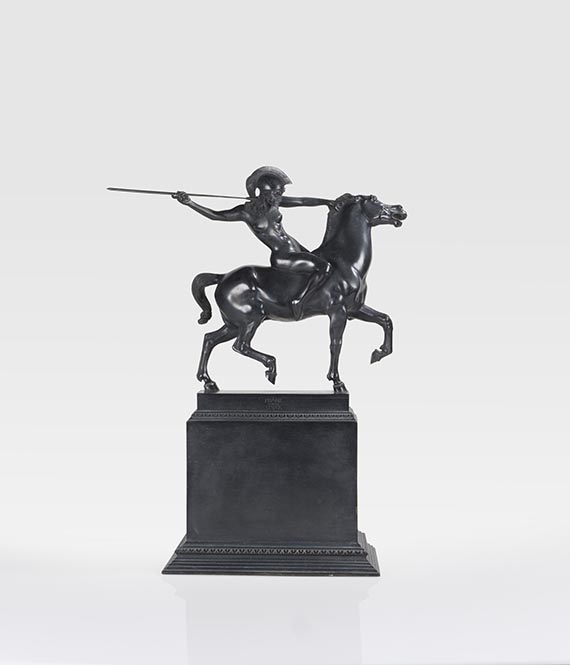Video
Back side
358
Franz von Stuck
Amazone, 1897.
Bronze with black patina
Estimate:
€ 15,000 / $ 16,050 Sold:
€ 38,100 / $ 40,767 (incl. surcharge)
Amazone. 1897.
Bronze with black patina.
Inscribed "Franz von Stuck" on the front of the plinth. Upper left edge of base with the foundry mark "Guss C. Leyrer München". 65 x 40.3 x 17.5 cm (25.5 x 15.8 x 6.8 in).
Cast after 1906 (Stuck was ennobled in 1906). Spear remade.
PROVENANCE: Private collection Saarland (acquired before 1994).
EXHIBITION: (Selection, each a different copy)
Erste Ausstellung der Vereinigung Bildender Künstler Österreichs, Vienna, March 1898
Internationale Kunst-Ausstellung des Vereins bildender Künstler Münchens, Secession, April-September 1898, no. 396
Sünde und Secession. Franz von Stuck in Wien, Unteres Belvedere, Vienna, July 1 - October 9, 2016, pp. 202-205 (illu.).
LITERATURE: Fritz von Ostini, Franz von Stuck: Gesamtwerk, Munich 1909, pp. 142-143 (illu.).
Otto Julius Bierbaum, Stuck, Bielefeld/Leipzig 1924, pp. 134-135 (illu.).
Thomas Raff, "Die Kraft des Mannes und die weiche Schmiegsamkeit des Weibes": Franz von Stuck: Das plastische Werk, ex. cat. Franz von Stuck Geburtshaus Tettenweis 2011, pp. 44-47 (different copy).
Bronze with black patina.
Inscribed "Franz von Stuck" on the front of the plinth. Upper left edge of base with the foundry mark "Guss C. Leyrer München". 65 x 40.3 x 17.5 cm (25.5 x 15.8 x 6.8 in).
Cast after 1906 (Stuck was ennobled in 1906). Spear remade.
PROVENANCE: Private collection Saarland (acquired before 1994).
EXHIBITION: (Selection, each a different copy)
Erste Ausstellung der Vereinigung Bildender Künstler Österreichs, Vienna, March 1898
Internationale Kunst-Ausstellung des Vereins bildender Künstler Münchens, Secession, April-September 1898, no. 396
Sünde und Secession. Franz von Stuck in Wien, Unteres Belvedere, Vienna, July 1 - October 9, 2016, pp. 202-205 (illu.).
LITERATURE: Fritz von Ostini, Franz von Stuck: Gesamtwerk, Munich 1909, pp. 142-143 (illu.).
Otto Julius Bierbaum, Stuck, Bielefeld/Leipzig 1924, pp. 134-135 (illu.).
Thomas Raff, "Die Kraft des Mannes und die weiche Schmiegsamkeit des Weibes": Franz von Stuck: Das plastische Werk, ex. cat. Franz von Stuck Geburtshaus Tettenweis 2011, pp. 44-47 (different copy).
The depiction of the fighting or spear-throwing Amazon is probably Franz von Stuck's best-known sculptural work, a monumental version of which has been in front of the portico of the Villa Stuck in Munich since 1936. Stuck may have first become interested in such a motif during his stay in Rome with Max Klinger around 1890, when he was able to immerse himself in the world of ancient mythology and its sculptural and painterly realization. Surrounded by the most outstanding works of Greek and Roman sculpture, but also those of the Renaissance and the Baroque, the "Wounded Amazon" of Polyclet, which was later also placed on the attic of his villa, or the equestrian statue of Marcus Aurelius on the Capitol Square laid out by Michelangelo, may have had an inspiring effect. When Stuck remodeled his studio in 1901/02, he had a plaque placed there with the names of his artistic models. Sculpture is represented by Phidias, the greatest sculptor of Greek Classicism, and Michelangelo, whose sculptures were significant for Stuck in their powerful monumentality. Further inspiration came from a head of Pallas Athena, exhibited in the Munich Glyptothek, of which Stuck had a plaster cast. A first painting depicting a combative Amazon, though only the helmeted head, was also created in 1897; in the background Stuck shows the stone-throwing Centaur, who in a painterly version of the motif from 1912 forms the male counterpart to the Amazon. In the theme of the battle of the sexes, so present in Stuck's oeuvre, the figure of the Amazon fits in naturally, but with a different quality. The bellicose women of Asia Minor, already described in Homer's Iliad in the battle of the Amazons against the Greeks besieging Troy and the defeat of their queen Penthesileia by Achilles, had found its way into art in form of the motif of the Amazon battle and the wounded Amazon. In addition to the coy game of tag and dance, the encounter of the sexes in Stuck's work can turn into a wild chase and even violent subjugation. In contrast to Stuck's other female figures, the athletic, fearless warrior, for whom Lydia Feez posed as model, uses her body not for lascivious seduction but for attack. She controls her (male) horse with the strength of her thighs, which hold the horse's body tight. With fierce determination, her hand grabs the mane to pull the horse's head to the side and hurl the lance at her opponent. Completely naked, her only armor is a helmet on a wild head of hair, she rides the horse in a gentleman's seat with the spear in hand. Stuck's female figure is endowed with distinctly masculine and sexual attributes. A woman on horseback seems somewhat unusual in sculpture, as such a representation is generally reserved for male military leaders or princes in the tradition of Roman antiquity or the Renaissance. Stuck's Amazone was exhibited for the first time with great success in Vienna and Munich in 1898 and was subsequently reproduced in the magazine "Jugend"; casts were soon purchased by some of the most important museums. Finally, in 1911/12, the Kölnischer Kunstverein commissioned a large sculpture of the Amazone for the sculpture collection of the Wallraff-Richartz-Museum, which Stuck produced with slight modifications of the small version. The extension of the Villa Stuck, which Stuck had built with the aim of producing large sculptures in his new studio, was also carried out in this context. [KT]
358
Franz von Stuck
Amazone, 1897.
Bronze with black patina
Estimate:
€ 15,000 / $ 16,050 Sold:
€ 38,100 / $ 40,767 (incl. surcharge)




 Lot 358
Lot 358 
